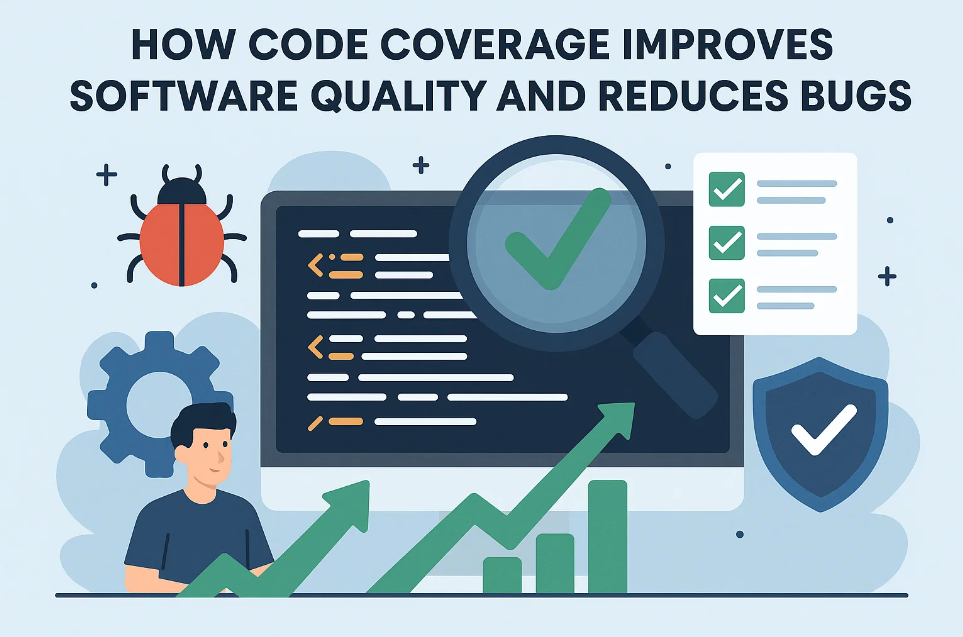In modern software development, ensuring high-quality code is no longer optional—it’s essential. From agile teams deploying weekly updates to enterprises maintaining mission-critical systems, every software project benefits from robust testing strategies. One of the most effective ways to evaluate how well your tests validate your code is by tracking code coverage.
Code coverage provides measurable insight into how much of your application’s source code is executed during testing. The higher the coverage, the more confident teams can be that their code behaves as expected and potential defects are caught early. But code coverage is not just about achieving high numbers—it’s about using that data strategically to improve software quality and reduce bugs.
What Is Code Coverage?
Code coverage is a software testing metric that indicates how much of the application’s source code has been executed by automated tests. It helps testers and developers understand which parts of the codebase are tested and which are not.
Common types of code coverage include:
-
Statement coverage: Checks whether each statement in the program has been executed at least once.
-
Branch coverage: Verifies that every possible branch (such as “if” or “else” conditions) has been executed.
-
Function coverage: Ensures that every function or method in the code is called during tests.
-
Path coverage: Tests all possible execution paths through the code.
-
MC/DC coverage (Modified Condition/Decision Coverage): Commonly used in safety-critical systems, this ensures that all conditions in a decision have been independently tested.
By measuring code coverage, development teams gain visibility into which parts of their code are sufficiently tested and where more attention is needed.
Why Code Coverage Matters for Software Quality?
The relationship between code coverage and software quality lies in how well-tested code leads to more predictable and stable outcomes. Here’s how it helps:
1. Detecting Untested Code Areas
Code coverage analysis highlights untested or under-tested parts of the codebase. These areas often hide critical logic that, if left unchecked, can introduce bugs later. Knowing exactly where testing gaps exist helps QA engineers prioritize what to test next.
2. Reducing Bug Density
Higher code coverage generally leads to fewer defects in production. When most of your code is exercised during automated testing, potential logic errors, integration issues, and performance bottlenecks are caught earlier in the pipeline.
3. Enabling Confident Refactoring
Developers frequently refactor code to improve maintainability or performance. Without good test coverage, refactoring can introduce new bugs. Code coverage ensures that enough tests are in place to validate that existing functionality remains intact after changes.
4. Improving Maintainability and Readability
When teams write tests to achieve meaningful coverage, they also end up writing cleaner, modular, and more testable code. The discipline of writing testable code directly contributes to better software architecture and long-term maintainability.
5. Supporting Continuous Integration and Delivery (CI/CD)
In modern CI/CD pipelines, automated testing and code coverage analysis work hand in hand. Tools like Jenkins, GitHub Actions, and GitLab CI integrate with coverage tools to enforce minimum thresholds before merging code. This prevents low-quality code from entering production.
How Code Coverage Helps Reduce Bugs?
Achieving high-quality software is all about identifying and fixing bugs before users do. Code coverage plays a crucial role in this process.
Early Detection of Logical Errors
Coverage reports make it easier to identify untested decision paths and logical conditions. By ensuring every conditional branch is tested, developers catch errors in logic that might otherwise slip through manual reviews.
Improved Regression Testing
When new features are added or bugs are fixed, there’s always a risk of breaking existing functionality. High code coverage ensures that regression tests run across most of the codebase, quickly identifying unintended side effects.
Enhanced Collaboration Between QA and Developers
Code coverage metrics serve as a shared language between developers and QA teams. Instead of guessing test effectiveness, they can align on measurable goals—like increasing branch coverage from 60% to 85%—to improve overall software reliability.
Prevention of Technical Debt
Low test coverage often correlates with technical debt—undocumented, fragile, and risky code. Tracking coverage over time helps teams maintain testing discipline, preventing quality from eroding as the project grows.
Tools for Measuring Code Coverage
There are many tools available to measure and visualize code coverage. The choice depends on your programming language, testing framework, and CI/CD environment. Here are some popular options:
-
Keploy: An open-source testing and coverage platform that automatically generates tests from API calls, integrates with CI/CD, and helps teams measure code and API coverage effectively.
-
JaCoCo: A widely used Java code coverage tool that integrates with Maven and Gradle.
-
Istanbul (nyc): A JavaScript and TypeScript coverage tool that works with Jest and Mocha.
-
Coverage.py: The go-to coverage tool for Python applications, often used with pytest.
-
Cobertura: A simple tool for Java that reports line and branch coverage.
-
Clover: A commercial option with advanced analytics for large enterprise codebases.
Most modern IDEs and CI tools can also display coverage results directly in dashboards, helping teams visualize trends over time.
Best Practices for Using Code Coverage Effectively
1. Don’t Chase 100% Coverage
It’s tempting to aim for perfect coverage, but that’s rarely realistic or cost-effective. Focus on covering the most critical and high-risk parts of your application—like core business logic or frequently changing modules.
2. Combine Coverage with Quality Metrics
Code coverage alone doesn’t guarantee quality. Pair it with other metrics such as defect density, cyclomatic complexity, and static code analysis to get a more accurate picture of code health.
3. Automate Coverage Tracking
Integrate coverage analysis into your CI pipeline so that it runs automatically with every build. This ensures you’re always aware of the current testing status and can block low-coverage code merges.
4. Visualize Coverage Reports
Use tools that generate visual reports, such as color-coded files or dashboards. These help teams quickly identify which files or functions need additional tests.
5. Regularly Review Coverage Thresholds
As projects evolve, testing priorities may shift. Adjust your minimum acceptable coverage thresholds over time based on the criticality and complexity of different modules.
Limitations of Code Coverage
While code coverage is a valuable metric, it should never be the only measure of test effectiveness. It doesn’t tell you if the tests themselves are good or if they verify correct outcomes. For instance, you can achieve 100% statement coverage without actually validating functional correctness.
That’s why teams should focus on test quality, not just quantity. Meaningful test cases, clear assertions, and a mix of unit, integration, and end-to-end tests provide a more holistic assurance of software reliability.
Conclusion
Code coverage is one of the most practical and measurable indicators of test effectiveness in software development. By identifying untested code, preventing regressions, and supporting continuous integration workflows, it directly contributes to better software quality and fewer bugs in production.
However, the goal isn’t to chase a number—it’s to ensure that the tests you write truly validate your application’s logic, performance, and reliability. When used wisely alongside other quality metrics, code coverage becomes a cornerstone of a mature, data-driven testing strategy.


Leave a Reply